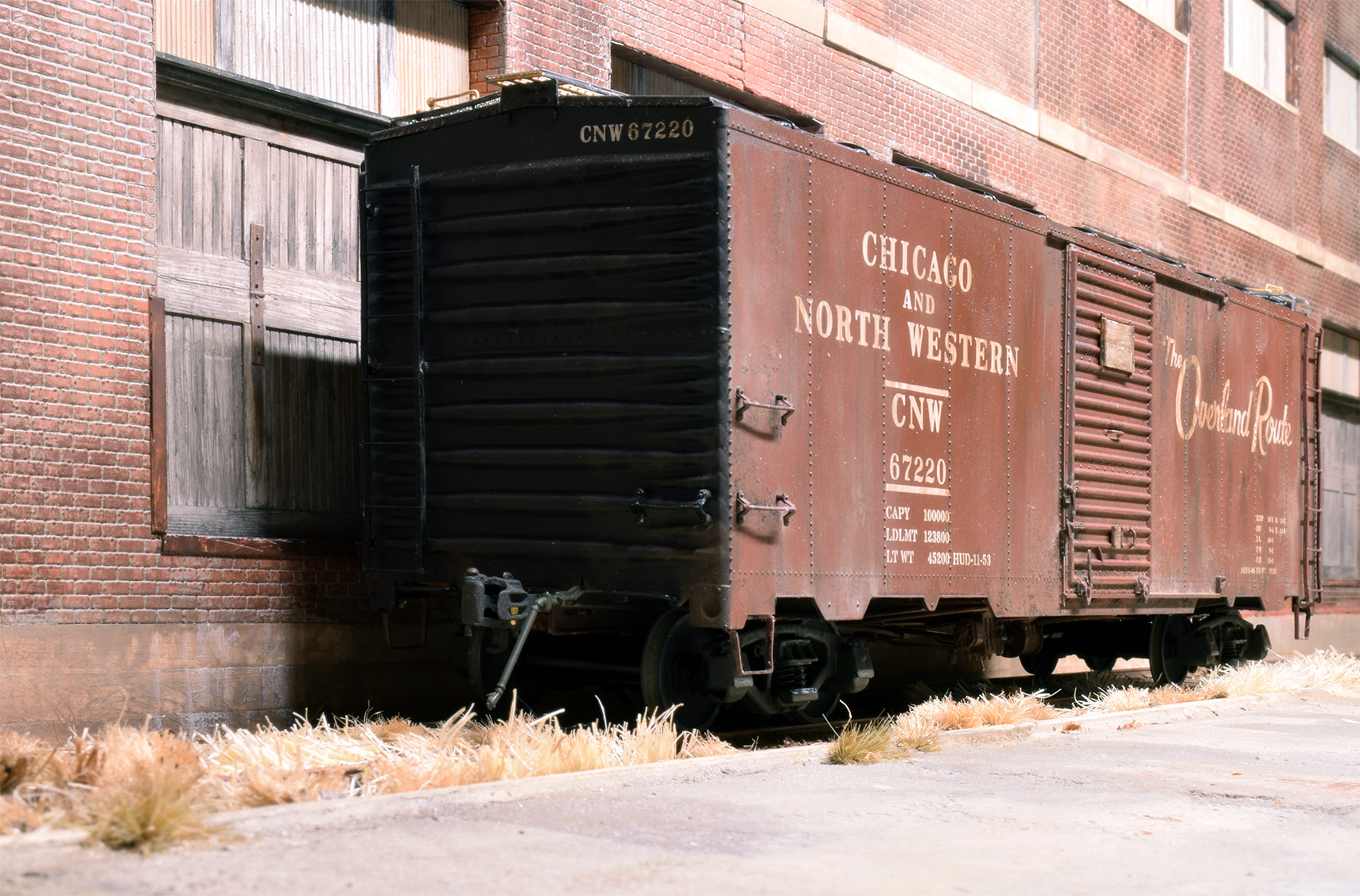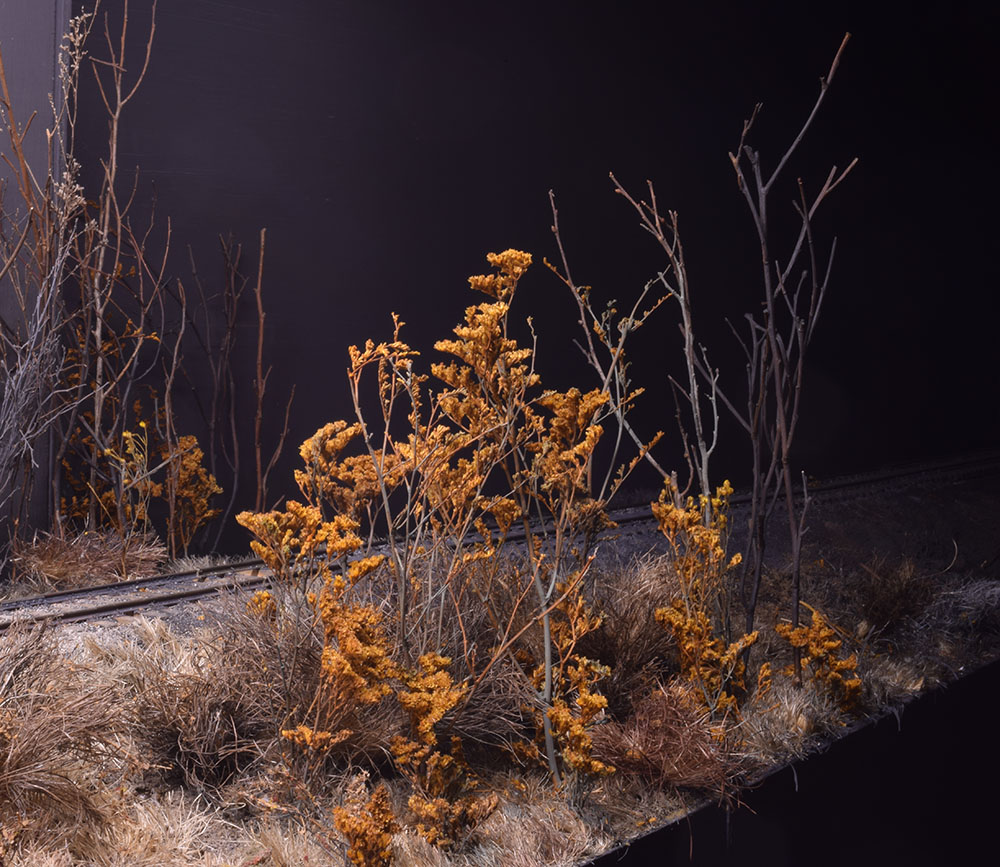To recreate the expansive space that we experience outside, we resort to tricks ranging from a plain blue color on the walls to large custom made photomurals.
As I’ve progressed through the craft, I’ve reached the conclusion the backdrop is not as necessary as I used to think.
Scale Truly Makes A Difference
I’ve said before that each scale has a natural viewpoint. N and HO favor more panoramic scenes whereas moving up in size to S, quarter-inch, and the many variants of 1:22.5, the focus shifts from a broad vista to an emphasis on the individual objects.
Where Is Your Focus?
If the trains are the sole focus for many, then why not push that focus all the way? This quarter-inch scale scene below is truly shallow in depth, which, combined with the eye level viewpoint, creates the immersive sense that you are standing next to the boxcar instead of looking down on it from above. The warehouse flat is a natural backdrop that stops the eye and generates a sense of enclosure typical of tightly packed urban environments.

This image works because the relationships are what we expect to see at full scale. Your eye level forces you to look up at the car because it towers over you. At this close range, the building dominates your field of vision and blocks long distance sight lines. Is there a design lesson to learn here?
Going forward, I now question the need for an artificial backdrop even for a rural subject. I’ve experimented with dark backgrounds before and like what they do visually. With nothing to look at, the eye is drawn to the modeling because of the contrasts in color and textures. The photo below is an example of this principle at work.

With nothing else to attract the eye, your attention naturally goes to the bright colors in the foliage. Here, the lack of a blue sky or sense of distance is of little concern.
Different Backgrounds For Different Scenes
For whatever comes next, I won’t bother with traditional background sky or scenery. Like the warehouse scene and landscape above, my focus will be on the foreground. I can see a dark colored surface to frame the modeling along with different screening devices such as a dense layer of trees and scrubby undergrowth, tall retaining walls, or cuts and other natural elements instead of trying to mimic sweeping views.
As with the warehouse, these elements will be closer to full scale rather than being compressed from a lack of space. There will be plenty of visual interest to hold the eye, as a dark featureless background provides no contrast to draw your gaze away.
Next?
It’s my belief that if we’re not growing as modelers, then we’re only treading water. It’s a time of experimentation for me. A time to challenge my own perceptions and bias around what makes for a personally meaningful path in the craft. The ideas in this series aren’t for every taste, nor do I intend them to be. They are the result of much soul searching and uniquely fit where I’m at artistically. They are here for the taking if you’re interested, otherwise feel free to ignore them.
Next time I start putting these notions to work.
Regards,
Mike
Designing Your Thinking Part Four: Time To Let Go of The Box?
It is amazing how not including a backdrop frames attention on rural details. That tree looks stunning and I can’t stop looking at that photograph. That foliage is no less a model and it’s interesting how the dark backdrop and planned lighting helps us see it while also providing some wayfinding assistance, guiding us through the scene.
I still think what you did with that massive brick warehouse was quite innovative. It’s size equals a traditional sky backdrop so it plays a similar role but instead of being a placeholder for a missing layout it’s an interactive piece of the scene. Also, because it’s edges are the layout’s perimeter we don’t see that it’s flat and instead explore its subtle visual textures. As you note, the presence of O scale invites us into the scene on a very personal level.
Your thoughts compliment nicely your earlier thoughts on the transition into staging areas.
Reading this and thinking about staging and backdrops made me think about a social construct the hobby perpetuates: that of inadequacy. We never have enough space in length of run for our trains, depth to model the whole scene, so sometimes these aids aren’t as much theatrical but concessions making up for what we want but can’t have. Your approach here, like Jonathan Jones’ on his layout, looks within the scene to enjoy what is centre of plate instead of what’s missing from the table.
Chris
(Retaining) walls are a great background: they eye quite naturally stops at the top of it. No extraneous detail, save maybe the capping bricks along the top. Quick and easy to create, too!
Mike,
Your comments made me think about my outdoor layout I’m building in 1/29. I have no backdrop, nor at planning one, but yet it’s not something that is bothering me. Because my focus is on my massive structures. I have a major feed mill that scales out to 6’x 7′ x 4′ tall on top of a 45″ layout height. It towers over the trains even when mocked up.
This is only part of the structure but my house on the left will be hidden behind the rest of the structure. But at eye level it’s already forcing the eye to see how big the building is.
https://live.staticflickr.com/65535/51961831795_2d09f357af_c.jpg
Thanks for making me think! It’s a fun exercise.
Hope this link works:
https://ewjr.files.wordpress.com/2023/01/0c41e3f1-09a0-4fb8-8c0e-30561647b225.jpeg?w=300&h=200
Craig, You’re welcome. I imagine that a scale that size changes the equation entirely from what people are used to with indoor modeling. Outdoors, why would you even consider an artificial backdrop?
-Mike
Simon,
“(Retaining) walls are a great background:”
Yes they certainly can be. Your photo link works fine on my end. Thank you.
-Mike